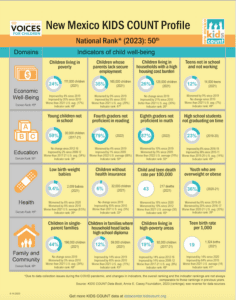
NM ranks last in child well being
Annual Kids Count survey tracks poverty, education and more
Andy Brosig/News-Sun
It’s an unenviable position to occupy as New Mexico ranks worst in the United States in terms of overall childhood well being — again.
That according to the annual Kids Count survey by the Annie E. Casey Foundation, an analysis of multiple factors that give an overall picture of how children and families are faring in the U.S. today.
New Mexico hasn’t ranked better than 49th in the country for more than a decade, according to the study.
Kids Count tracks four major indicators of childhood well being — economic, educational, health and family and community — to determine rankings.

Each major indicator covers four sub-categories that drill down into factors to determine what’s needed for kids and families to succeed.
For the most recent year, for example, New Mexico ranked 48th in terms of children living in poverty at 24 percent, the report states, with 12 percent of teens not in school and not working, or about 12 percent.
More than a third of the parents of New Mexico’s children don’t have secure employment, and more than a quarter of low-income families face the burden of high housing costs.
“That’s my population,” said Patricia Grovey Evans, founder and director of Child and Family Services Inc. of Lea County, which provides Head Start services and family education programs in and around Hobbs.
“When children are born in poverty, it impacts them in many ways,” Evans told the News-Sun. “Not just education — food scarcity, parents (who) need support and educational resources to empower their knowledge and skills. When a child is born into a family with no resources, who have no skills to help that child develop, we’re just going keep repeating those cycles.”
And food scarcity in particular has much wider-reaching impacts on children, Evans said.
Children of families living in poverty may have limited or no regular access to nutritious food, which has negative impacts on cognitive development, she said.
Financial investment at the state level in various programs has the promise of helping raise those family’s quality of living, Evans said. It may take three to five years before progress from that investment is reflected in the data, she said, but things are getting better.
But financial investment in the state’s children is only part of the answer, Evans said.
Making sure that assistance is reaching the families who need it most is key, she said.
“We still have work to be done,” Evans said. “Some of the children who are most vulnerable maybe aren’t being reached. We need to do better targeting services to those (underserved) populations.
“Looking at the Hobbs community now, we still have housing instability, increased violence, child abuse is increasing. All of those things. When a child is born into poverty all the ills of poverty come on that child.”
Other areas where the Land of Enchantment is falling short include educational achievement, the study found.
While the state ranks 38th nationally in children aged 3-4 attending preschool programs, about 59 percent, New Mexico still ranks near the bottom in literacy indicators, with about 79 percent of fourth graders not proficient in reading and 87 percent of eighth-grade students falling short in mathematics.
Under the health category, just 6 percent of New Mexico children don’t have health insurance.
On the other side of the coin, the state ranked 45th in child and teen deaths, with 43 per 100,000, showing a steady increase over at least the past decade.
Ranked 48 in the country, 44 percent of New Mexico children live in single-parent families, and 12 percent are in a home where the head of household lacks a high school diploma.
Some 19 percent of children live in high poverty areas, the survey found.
On a positive note, the number of teens giving birth has been in steady decline for more than a decade, with just 19 births per 1,000 teens age 15-19. That’s a significant decrease from 2013, where there were 53 births per 1,000 teens in the state.
Most of the data sets in the 2023 Data Book are from 2021.

New Mexico announced a dramatic expansion of child care assistance in July of 2021. That expansion was made with federal pandemic funding, but during the 2023 legislative session, lawmakers replaced that funding — which was about to expire — with state revenue so families would not lose their child care moving forward.
Though most consider those grim statistics, a press release from New Mexico Voices for Children, the state Kids Count contributing agency, stated it’s not all doom-and-gloom and progress is being made.
“The data shows that the state must keep pushing itself to create opportunities for all New Mexico kids to thrive, but we’ve also seen progress in most indicators, and many recent family-focused state policy changes give us strong reasons to expect that we’ll continue to see improvements in the future,” said Amber Wallin, executive director of NMVFC, in a release.
But, as Evans said, there’s still much work to be done.
The News-Sun attempted to contact New Mexico Voices for Children several times, seeking a county-by-county breakdown of the numbers. The agency’s communications director Sharon Kayne did not answer calls, and her voice mailbox was full and not accepting messages.










